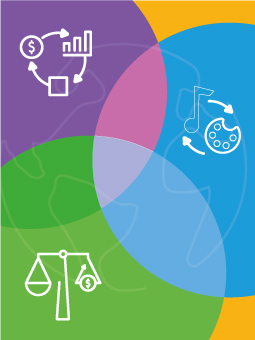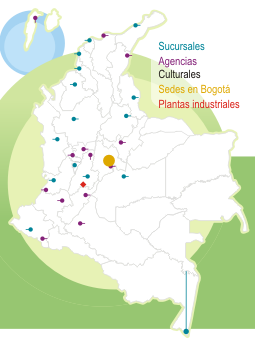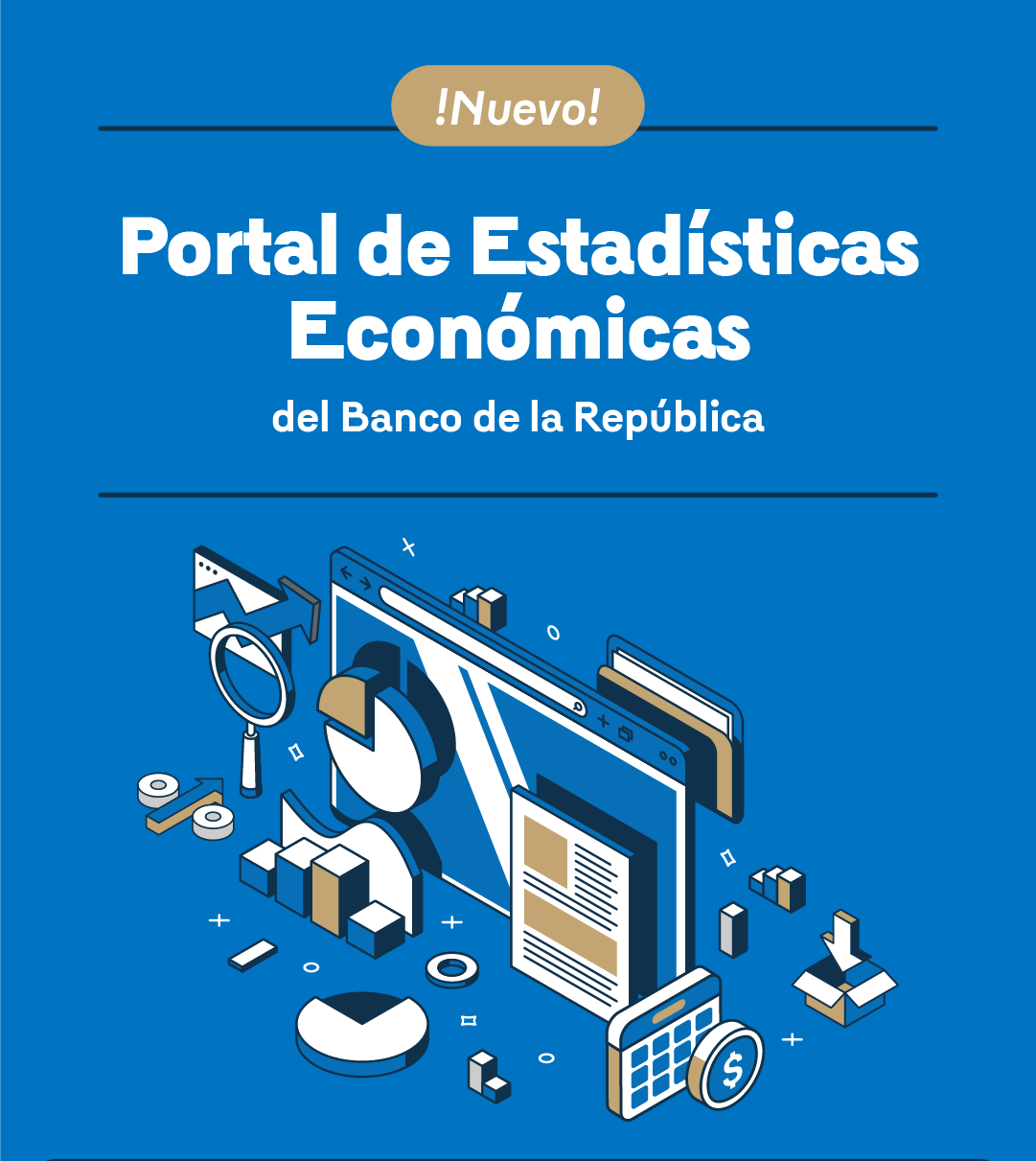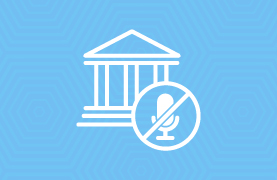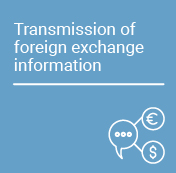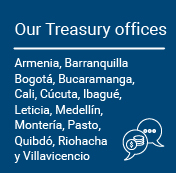Servicios
|
Banco de la República (the Central Bank of Colombia, BR) hereby informs that in August 2020 it did not make any purchases or sales of TES B in the market. At the end of August, the outstanding balance of TES held by BR was COP $20,702.0 b (value at market prices).
The TES portfolio of…
|
|
Banco de la República (the Central Bank of Colombia, BR) hereby informs that in July 2020 it did not make any purchases or sales of TES B in the market. At the end of July, the outstanding balance of TES held by BR was COP $20,790.7 b (value at market prices).
The TES portfolio of BR (…
|
|
At the end of June, the outstanding balance of TES held by BR was COP $20,540.3 b (value at market prices). The TES portfolio of BR (expressed in nominal terms) is composed of peso-denominated TES (COP $15,928.8 b) and UVR-denominated TES (UVR 8.2 b.).
In July 2020, none of the TES B held…
|
|
Banco de la República (the Central Bank of Colombia, BR) hereby informs that in May 2020 it did not make purchases or sales of TES B in the market, and that it carried out a debt swap operation with the Government for COP $1,766 billion (nominal value)
|
|
Banco de la República (the Central Bank of Colombia, BR) hereby informs that in April 2020 it made outright purchases of TES B in the secondary market for COP $837.1 billion (value at market prices). At the end of April, the outstanding balance of TES held by BR was COP $19,909.6 b (valued…
|
|
On 27 March 2020, Banco de la República announced that the maturities of NDFs that expired before 25 April 2020 would be renewed.
This announcement was mistaken in the sense that the date announced should have been that of the day following the April meeting of the Board of Directors. Thus, all…
|
|
Banco de la República (the Central Bank of Colombia) will roll over forward contracts maturing in November.
At its meeting today, the Board of Directors of the Central Bank (BDBR) decided to roll over non-delivery forward contracts for the sale of US dollars through auctions held on the dates of…
|
|
[Video] Press Conference with the Governor of the Central Bank of Colombia
Juan José Echavarría, Governor, and Hernando Vargas, Deputy Technical Governor, answer questions from analysts and journalists related to the decision reached today by the Board of Directors.
|
|
The Board of Directors of the Central Bank of Colombia (BDBR), by majority, reduced the benchmark interest rate by half a percentage point to 2.75%. In this way, it continues with the countercyclical monetary policy stance.
This decision took the following elements into consideration:
|
|
For this decision, the Board mainly took into account the following elements:
|
|
On Monday 16 March 2020, the members of the Board of Directors of the Central Bank met with the Technical Deputy Minister of Finance in the morning, and with the Financial Superintendent in the afternoon, to monitor market dynamics, indicators of the financial system, and the results of the…
|
|
[Video] Press Conference with the Governor of the Central Bank of Colombia
Juan José Echavarría, Governor, and Hernando Vargas, Deputy Technical Governor, answer questions from analysts and journalists related to the decision reached today by the Board of Directors.
|
|
The Board of Directors of Banco de la República (BDBR), by majority, reduced the Benchmark Interest Rate by half a Percentage Point to 2.50%. In this way, it continues with the countercyclical monetary policy stance.
This decision took the following elements into consideration:
|
|
The Board of Directors of Banco de la República (BDBR) unanimously decided to lower the Benchmark Interest Rate by one fourth of a Percentage Point to 2.25%. This decision took the following elements into consideration:
|
|
The Board of Directors of Banco de la República, at today’s meeting, unanimously decided to maintain the benchmark interest rate at 1.75%. For this decision, the Board mainly took into account the following elements:
|
|
At its meeting in November 2017, the Board of Directors of Banco de la República (BDBR) adopted a new scheme for monetary policy decisions, according to which, ordinarily, no monetary policy decisions would be made in the months of February, May, August, and November each year.
|
|
During today’s meeting, the Board of Directors of the Banco de la Republica unanimously decided to hold the policy rate at 1.75%. This decision was made on the basis of the following considerations:
|
|
The Board of Directors is keeping the inflation target (annual change in the CPI) at 3% within a range between 2% and 4%.
The Board of Directors will continue careful monitoring of inflation trends, economic activity, the forecasts for these variables, and the international situation and reiterates…
|
|
The Minister of Finance, the Governor of Banco de la República (the Central Bank of Colombia), and the Financial Superintendent hereby inform that:
The members of the Board of Directors of Banco de la República, the Minister of Finance and Public Credit, and the Financial Superintendent of Colombia…
|
|
The Board of Directors of the Central Bank of Colombia (BDBR) unanimously reduced the benchmark interest rate by a quarter percentage point to 2.0%. For this decision, the Board mainly took into account the following elements:
|
|
In accordance with the Colombian Constitution, the Board of Directors of Banco de la República (BDBR) is the credit authority of the Colombian economy. Law 31 of 1992 constitutes the general framework of reference for the exercise of the functions attributed to the Board as credit authority.
|
|
The monetary policy strategy of Banco de la República (the Central Bank of Colombia) aims to maintain a low and stable inflation rate, as well as to reach output levels close to its potential. Additionally, Banco de la República’s policy contributes to preserve financial stability and to the proper…
|
|
The following information is available in English, please remember that the translations made by Banco de la República with respect to the contents of its websites are for information purposes. More info in Terms and Conditions: Monetary PolicyThe strategy behind Banco de la República’s policy…
|
|
This translation includes:
|
|
Artículo publicado en: Macroeconomics and Finance in Emerging Market Economies (Taylor and Francis), vol. 6, núm. 1, pp: 131-145, 2013.
|






